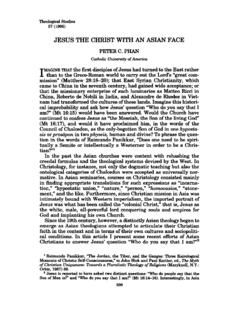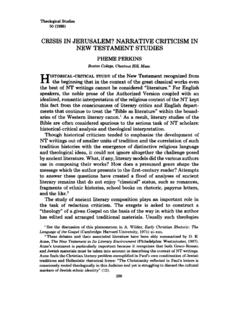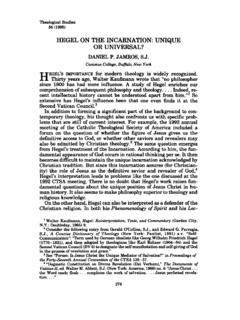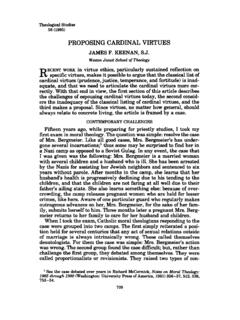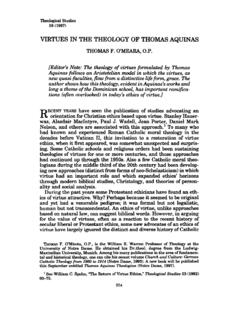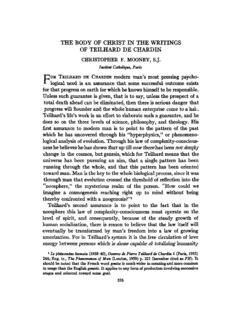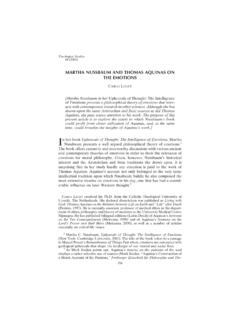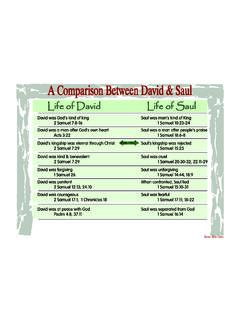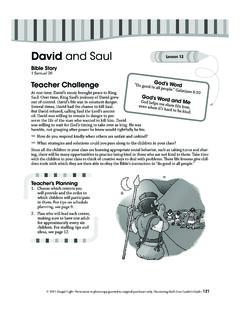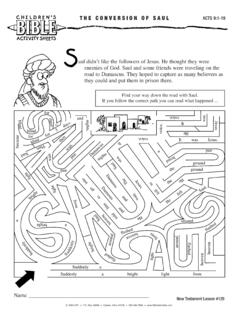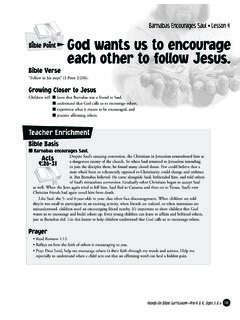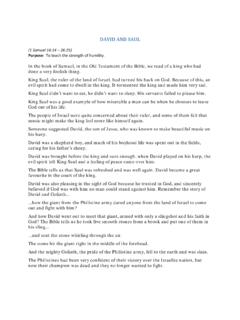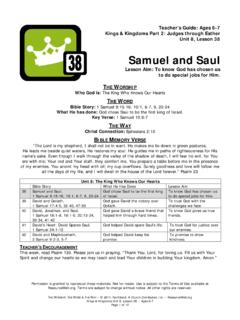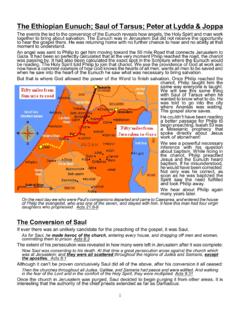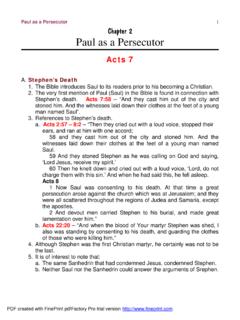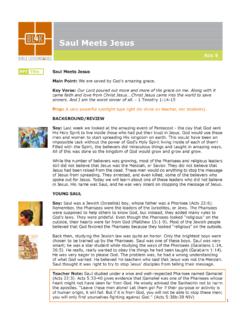Transcription of THE INFLUENCE OF SAUL ALINSKY ON THE CAMPAIGN FOR …
1 Theological Studies 59 (1998) THE INFLUENCE OF SAUL ALINSKY ON THE CAMPAIGN FOR HUMAN DEVELOPMENT LAWRENCE J. ENGEL [Editor's note: The author argues that the CAMPAIGN for Hu-man Development, founded in 1969, is Catholicism's most significant and longest social experiment in the 20th century. A postconciliar response to an America in crisis, the CAMPAIGN is a unique theological resource in the development of an indig-enous North American theology. Central to its uniqueness was the bishops' embrace of the dean of community organizing, Saul David ALINSKY .] THE NATIONAL CONFERENCE OF CATHOLIC BISHOPS initiated in 1969 the most significant and longest-running experiment of 20th-century Catholic social action.
2 The founding resolution for this project read as follows: "There is an evident need for funds designated to be used for organizing groups of white and minority poor to develop eco-nomic and political power in their own communities.. Therefore be it resolved that the National Conference of Catholic Bishops establish a National Crusade Against Poverty. The crusade will commit the Church to raise a fund of 50 million dollars over the next several years."1 This crusade came to be known as the CAMPAIGN for Human Development (CHD).2 Twenty-nine years and over $225 million later,3 the experiment became an official department of the United States Catholic What was the origin of this experiment? Why would Catholic bishops approve funds for the poor to organize for power, much of which went LAWRENCE J.
3 ENGEL is assistant professor and director of Human Issues, an interdis-ciplinary education program, at Edgewood College, Madison, Wisconsin. He received his in theology from Marquette University. He served from 1984 to 1989 on the national staff of the CAMPAIGN for Human Development. He is currently researching the intellectual roots of Saul ALINSKY 's thought. 1 "Resolution on the Crusade against Poverty," adopted by the National Catholic Con-ference of Bishops, November 14, 1969, in Daring to Seek Justice, ed. James Jennings (Washington: United States Catholic Conference, 1986) 69. 2 The Crusade against Poverty was eventually renamed the CAMPAIGN for Human Development. 3 Timothy Collins, " CAMPAIGN for Human Development Press Release," September 8, 1997, United States Catholic Conference.
4 4 The CHD became an official department within the USCC in 1989. 636 CAMPAIGN FOR HUMAN DEVELOPMENT 637 to the community-organizing projects associated with Saul ALINSKY ?5 Was there a theology behind the CHD? Why was the original $50 million permitted to expand to over $225 million? What was validated within the experiment that led to the conclusion that providing funds for organized power groups was an official function of the Catholic Church, or perhaps more clearly stated, a constitutive dimension of Catholic life. By answering these questions one can show how the CHD became a unique theological resource in the development of a North American The origins of the CHD have not yet been definitively researched and Former NCCB President Bishop James Malone identifies two forces as foundational to the CHD: "the crisis of human needs and aspirations which was being experienced with peculiar urgency in American society," and the "impact of the Second Vatican Council.
5 "8 I shall briefly examine Malone's two forces here, and then, in the body of this article, deal with third force in the development of the CHD, the underrecognized INFLUENCE of Saul ALINSKY (1909-1972), the "dean of community-organizing."9 At first glance, such a claim about ALINSKY and Catholics may seem preposterous. How could the bishops be influenced bv an agnostic Jew popularly known as "Machiavelli in modern dress"?1 Yet ALINSKY organized his first community organization in Chicago's Back of the Yards in 1939, and critical to the success of ALINSKY 's first organization and all subsequent organizations was the foundational participation of the Catholic Church. Despite its foundational role, however, the re-lationship between the Church and ALINSKY has not been the subject of theological reflection within the Catholic Here I wish to provide some background for engaging in such reflection.
6 5 Rael Jean Isaac and Erich Isaac, The Coercive Utopians (Chicago: Regnery Gateway, 1983) 210. 6 This project is part of the broader North American theological projects of the John Courtney Murray Writers Group and within the argument developed by John A. Cole-man, , An American Strategic Theology (New York: Paulist, 1982). 7 To date, two texts have summarily addressed the origins of the CHD: Daring to Seek Justice, and Empowerment and Hope: 25 Years of Turning Lives Around, ed. James J. Jennings (Washington, : USCC CAMPAIGN for Human Development, 1996); the sec-ond text addresses the history of the CHD after 1985. 8 See his speech at the 15th-anniversary celebration of CHD in 1985, in Daring to Seek Justice, Introduction.
7 9 Harry C. Boyte, Community Is Possible (New York: Harper and Row, 1983) 34. 10 Wayne A. R. Leys, "Machiavelli in Modern Dress," The Christian Century 76 (No-vember 11, 1959) 1308-09. 11 More than 90% of the Back of the Yards population was Catholic. See Saul D. ALINSKY , "Community Analysis and Organization," The American Journal of Sociology 141 (1941) 797-808. For a description of Catholic involvement in ALINSKY organizations during the 1940s through the early 1970s, see P. David Finks, The Radical Vision of Saul ALINSKY (New York: Paulist, 1984). From the early 1970s to the early 1990s, see Cynthia Perry, IAF: Fifty Years (Franklin Square, : Industrial Areas Foundation, 1990). 12 Charles E. Curran, "Saul D.
8 ALINSKY , Catholic Social Practice, and Catholic Theory," Directions in Catholic Social Ethics (Notre Dame: University of Notre Dame, 1985) 147. 638 THEOLOGICAL STUDIES Human Needs in America in the 1960s The decade of the 1960s has been described variously as "the most eventful and tumultuous decade of the twentieth century,"13 "a period of crisis,"14 "a profound cultural upheaval,"15 and as a "revolutionary moment."16 This was the decade of Neil Armstrong's walk on the moon, the Cuban missile crisis, the escalation of the Vietnam conflict, and the Civil Rights movement. It was the time of the "New Frontier" and the "Great Society," a time influenced by the powerful oratory of John F. Kennedy and Martin Luther King, Jr., and then shattered by their deaths.
9 These were years marked by an ever expanding national obitu-ary: June 1963, NAACP leader Medgar Evans murdered; September 1963, four children die in a church bombing; November 1963, President John Kennedy assassinated; August 1964, three civil rights workers found dead; February 1965, Malcolm X murdered; March 1965, "Bloody Sunday"; March 1965, Viola Liuzzo murdered; April 1968, Martin Luther King assassinated; June 1968, Robert Kennedy assas-sinated. These deaths, combined with nightly TV news stories of the thousands of American GIs killed in Vietnam, made the 1960s a decade of vision and hope buffeted by death. For Catholics, the decade began with national recognition and leadership of one of their own. The 1960 presidential election of John F.
10 Kennedy symbolized Catholic assimilation into the mainstream of American society. Until then Catholics had understood themselves as an immigrant community intent upon building, serving, and culti-vating separate communities and civil Kennedy's elec-tion showed that Catholics were no longer standing on the immi-grant margins of society but had arrived within the cultural main-stream and were among the power elite of public life. A partial list of prominent lay Catholics involved in public life included Robert Kennedy, Eugene McCarthy, Peter Grace, William Buckley, and William Shriver. Kennedy's election confirmed what Catholic theolo-gians were heralding in significantly titled books such as The Emerg-ing Layman and A New 13 John Tracy Ellis, American Catholicism, 2nd ed.
